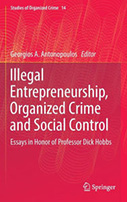Illegal Entrepreneurship, Organized Crime And Social Control: Essays In Honor Of Professor Dick Hobbs

Editor: Georgios A. Antonopoulos
Publisher: New York: Springer, 2016. 360p.
Reviewer: Jay Albanese | March 2017
Dick Hobbs is a British sociologist who has had considerable influence in doing research on the connections among crime, political economy and working-class culture. His Ph.D. dissertation at the University of Surrey became a book titled Doing the Business: Entrepreneurship, the Working Class and Detectives in the East End of London (Oxford University Press, 1988). Since then, he has been a prolific researcher and author, and his work has been recognized with multiple awards.
Much of Hobbs’ work is ethnographic in nature, connecting the local organized crime activity (e.g., illicit drugs, cigarette smuggling) with the upperworld of ‘legitimate’ society, showing their symbiotic nature as almost naturally occurring phenomena. Hobbs focuses on organized and professional crime, the night-time economy of London, and how the local context provides a means of understanding larger social problems. Hobbs’ work relies heavily on interviews with primary sources, and it might be said he paints pictures of criminal settings with rich, descriptive detail, rather than simply describing them. There are parallels between the approach and method of Hobbs in the UK and William Chambliss in the U.S., in using a bottom-up ethnographic approach to get to the larger issues of organized crime and the response/non-response to it. (see Chambliss’ classic book On the Take: From Petty Crooks to Presidents, 2nd ed. Indiana University Press, 1988).
Illegal Entrepreneurship, Organized Crime and Social Control is a festschrift comprised of 19 chapters written primarily by leading European scholars who have done research on organized crime and criminal markets. The book is divided into four parts, focusing on themes of interest to the individual authors — a number of which are directly related to Hobbs’ work.
The first section is the largest and most clearly reflects Hobbs’ interests in discussing the nature of organized crime. Chapters on a theory of organized crime, a taxonomy of criminal structures, bankruptcy fraud, organized crime in a particular province of the Netherlands, street-corner hustling, organized environmental crime in Calabria, illegal lending in Bulgaria, and Chinese women in criminal markets show a wide range of manifestations of organized crime. These reflect Hobbs’ focus on using local experiences gathered from the participants themselves to develop a larger picture of how illegal entrepreneurship develops and continues to thrive from the local neighborhood up to the global level.
The second section consists of only two chapters on financial crimes, including tax fraud and money laundering. These chapters focus on what happens to profits from illicit activity and how they are integrated into the legal economy. The overlap of interests between the underworld and the upperworld is evident in this section, as they both profit from disguising the source of illicit funds.
The third section consists of seven chapters describing efforts to control organized crime and the mixed success of these efforts. This section is interesting for the wide variety of case studies included: historical smuggling in Italy, biker groups in Norway, organized crime policy in Amsterdam, anti-trafficking efforts in Greece, gang interventions in East London, anti-fraud efforts in the Czech Republic and Romania, and responding to the financial market crises after 2007. Each of these chapters is quite different, but they respond to Hobbs’ call to understand the underlying behaviors and their motivations at the local level, if one is to develop appropriate and effective responses to them.
The fourth section consists of two chapters dealing with the ethnographic method itself, which characterizes much of Hobbs’ work. These contributions explain the importance of the ethnographic approach and the centrality of rich and carefully descriptive accounts of crime, and police and local conditions, in order to set the stage for proper understanding of organized and professional crime.
This volume, dedicated to honoring Dick Hobbs, is a welcome addition to the literature in highlighting both new insights into understanding organized crime and also the importance of the ethnographic method as a path to get there. The book should bring new attention to Hobbs’ work and contributions, and also to the work of his former students and colleagues. If you haven’t done so, you also might want to have a read of Hobbs’ book Lush life: Constructing Organised Crime in the UK (Oxford University Press, 2013) to get an even more direct sampling of his work and method.
Jay S. Albanese, Professor, Virginia Commonwealth University, Wilder School of Government & Public Affairs


